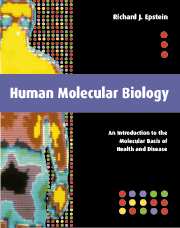Book contents
- Frontmatter
- Contents
- Preface
- Acknowledgements
- Read me first …
- Glossary
- Dedication
- Introduction: A disease for every gene?
- I From molecular biology to human genetics
- II From molecular genetics to human biochemistry
- III From molecular biochemistry to human cell biology
- 11 Signal transduction
- 12 Bioactive lipids and inflammatory cyotkines
- 13 Hormones and growth factors
- 14 Hemopoietins, angiogenins, and vasoactive mediators
- 15 Cell cycle control, apoptosis, and ageing
- IV From molecular cell biology to human physiology
- V From molecular physiology to human molecular biology
- Index
11 - Signal transduction
Published online by Cambridge University Press: 01 June 2011
- Frontmatter
- Contents
- Preface
- Acknowledgements
- Read me first …
- Glossary
- Dedication
- Introduction: A disease for every gene?
- I From molecular biology to human genetics
- II From molecular genetics to human biochemistry
- III From molecular biochemistry to human cell biology
- 11 Signal transduction
- 12 Bioactive lipids and inflammatory cyotkines
- 13 Hormones and growth factors
- 14 Hemopoietins, angiogenins, and vasoactive mediators
- 15 Cell cycle control, apoptosis, and ageing
- IV From molecular cell biology to human physiology
- V From molecular physiology to human molecular biology
- Index
Summary
Cells communicate with each other using a simple biochemical language. If the letters of this molecular alphabet are represented by elementary constituents such as pH and reactive ions, and the words by molecules such as glucose (food) and ATP (energy), then primitive sentences – e.g., stop dividing, start moving, change metabolic state – can be thought of as the sequential interaction of signaling molecules with their receptors. Much has been learnt about the spelling (structure) of these signaling molecules, but far less is known about the grammar of the intermolecular interactions that determine the outcome of cellular conversations. This section describes the basic vocabulary of cell signaling conversations.
Signal initiation
Proteins signal via inducible phosphorylation events
Molecules transmit information to other molecules. This process, termed signal transduction, comprises a cascade of on–off molecular switches involving the reversible phosphorylation of tyrosine, serine or threonine residues. Such phosphorylation events (which always occur intracellularly) may affect a single critical amino acid or multiple sites within target molecules. Transferred phosphates usually originate from ATP or GTP, depending upon the specificity of the signaling superfamily involved. Molecules regulating signal transduction cascades most often belong to one of the following groups (Figure 11.2):
1 Extracellular ligands.
2. Cell surface receptors.
3. Signaling enzyme effectors immediately downstream of receptors.
4. Nonenzymatic cytosolic second messengers.
5. Nuclear transactivators.
- Type
- Chapter
- Information
- Human Molecular BiologyAn Introduction to the Molecular Basis of Health and Disease, pp. 253 - 287Publisher: Cambridge University PressPrint publication year: 2002



